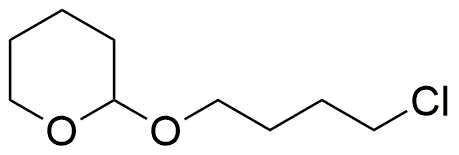2-(4-Chlorobutoxy)tetrahydropyran is widely utilized in research focused on:
- Pharmaceutical Development: This compound serves as an important intermediate in the synthesis of various pharmaceuticals, enhancing the efficiency of drug formulation processes.
- Agricultural Chemicals: It is used in the formulation of agrochemicals, providing effective solutions for pest control and crop protection, which are vital for improving agricultural yields.
- Polymer Chemistry: The compound acts as a building block in the production of specialty polymers, contributing to materials with enhanced durability and performance in various applications.
- Chemical Synthesis: It plays a crucial role in organic synthesis, allowing researchers to create complex molecules more efficiently, which is beneficial in both academic and industrial settings.
- Research Applications: This chemical is often used in laboratory settings to study reaction mechanisms and interactions, providing valuable insights for chemists and researchers.
General Information
Properties
Safety and Regulations
Applications
2-(4-Chlorobutoxy)tetrahydropyran is widely utilized in research focused on:
- Pharmaceutical Development: This compound serves as an important intermediate in the synthesis of various pharmaceuticals, enhancing the efficiency of drug formulation processes.
- Agricultural Chemicals: It is used in the formulation of agrochemicals, providing effective solutions for pest control and crop protection, which are vital for improving agricultural yields.
- Polymer Chemistry: The compound acts as a building block in the production of specialty polymers, contributing to materials with enhanced durability and performance in various applications.
- Chemical Synthesis: It plays a crucial role in organic synthesis, allowing researchers to create complex molecules more efficiently, which is beneficial in both academic and industrial settings.
- Research Applications: This chemical is often used in laboratory settings to study reaction mechanisms and interactions, providing valuable insights for chemists and researchers.
Documents
Safety Data Sheets (SDS)
The SDS provides comprehensive safety information on handling, storage, and disposal of the product.
Product Specification (PS)
The PS provides a comprehensive breakdown of the product’s properties, including chemical composition, physical state, purity, and storage requirements. It also details acceptable quality ranges and the product's intended applications.
Certificates of Analysis (COA)
Search for Certificates of Analysis (COA) by entering the products Lot Number. Lot and Batch Numbers can be found on a product’s label following the words ‘Lot’ or ‘Batch’.
*Catalog Number
*Lot Number
Certificates Of Origin (COO)
This COO confirms the country where the product was manufactured, and also details the materials and components used in it and whether it is derived from natural, synthetic, or other specific sources. This certificate may be required for customs, trade, and regulatory compliance.
*Catalog Number
*Lot Number
Safety Data Sheets (SDS)
The SDS provides comprehensive safety information on handling, storage, and disposal of the product.
DownloadProduct Specification (PS)
The PS provides a comprehensive breakdown of the product’s properties, including chemical composition, physical state, purity, and storage requirements. It also details acceptable quality ranges and the product's intended applications.
DownloadCertificates of Analysis (COA)
Search for Certificates of Analysis (COA) by entering the products Lot Number. Lot and Batch Numbers can be found on a product’s label following the words ‘Lot’ or ‘Batch’.
*Catalog Number
*Lot Number
Certificates Of Origin (COO)
This COO confirms the country where the product was manufactured, and also details the materials and components used in it and whether it is derived from natural, synthetic, or other specific sources. This certificate may be required for customs, trade, and regulatory compliance.

